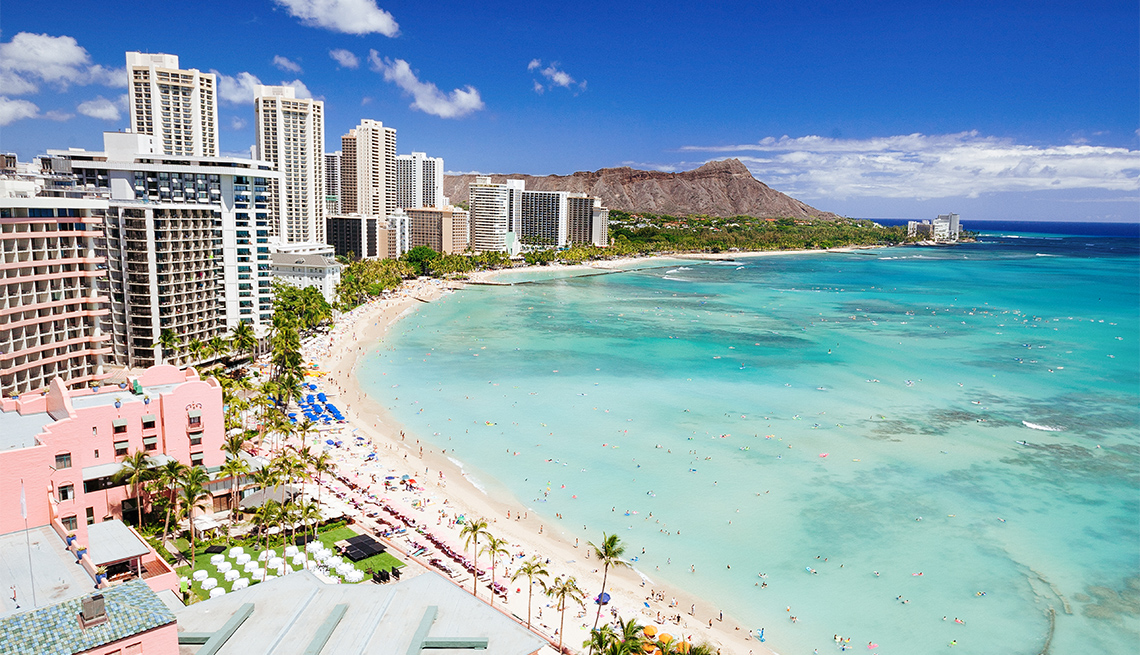AARP Hearing Center
When to go
Visitors flock to the island all year long, but the busiest (and most expensive) time to visit is during the winter holidays, with summer months a close second. The first few months of the year offer smaller crowds, slightly cooler temperatures, and whales, although rain is more likely during this time and ocean conditions tend to be more erratic. Spring is a good time to visit, but try to avoid the spring-break crowds. Fall months typically offer better deals and fewer visitors (September and October are great months, for example) but remember that the rainy season begins in November. While average temperatures in Hawaii only vary slightly — highs in the high 80s in summer and in the low 80s and high 70s the rest of the year — the presence of trade winds makes the difference between balmy and sticky.
Because of the distance from the mainland, Hawaii visitors prefer to settle in for a week or two — or even longer. For those not constrained by work and school schedules, timing a visit around long weekends like Thanksgiving, Labor Day and Memorial Day can offer decent deals and fewer visitors sharing your slice of the beach. On such occasions, you’re likely to happen upon a backyard or beach luau, or a holiday pot luck with local families enjoying a day off.
Ways to save: For the best prices, book during low-season dates. Don’t overlook the combined fly-and-stay deals offered by many airlines, but check them carefully to be sure you can’t do better on your own.
Where to stay
Oahu may be small — a scant 30 miles wide by 44 miles long — but it offers several distinct areas with unique offerings and appeal to visitors. Urban Honolulu, the state capital on the southeastern coast that includes Waikiki Beach, the downtown business district and lively neighborhoods like Chinatown and Kakaako, is steeped in surf, sand, dining and culture. On the island’s windward (east) side, gorgeous beaches define the region’s sleepy towns, with just enough shopping and dining to keep you from spending all day in the water. Surfing is the North Shore’s claim to fame, with iconic beaches known for massive waves (in winter) and epic views, as well as a smattering of food trucks and local hangouts. The Leeward (west) Coast is home to Ko Olina, a self-contained resort and golf community, plus a long stretch of beaches and rural communities that’s home to some of the most authentic native Hawaiian experiences on the island.
Oahu’s 300 hotels — mostly clustered in Waikiki with some along the North Shore and Leeward Coast — offer 58,000 rooms ranging from budget to pure luxury. Add timeshares and rental properties like Airbnb and VRBO to the mix, and simply deciding where to lay your head might be the decision most deserving of a mai tai upon arrival.
The historic Royal Hawaiian and Moana Surfrider hotels were the first two properties built along the 2.5-mile stretch of sandy beach in Waikiki, and they remain iconic as ever today among the myriad newer luxury, beachfront hotels. Living large comes at a high price in Hawaii, however, with rates starting from the mid $300s to $700-plus per night for a garden or restricted view.
Less pricey Waikiki options include the Hilton Hawaiian Village, a wandering complex where Elvis Presley filmed Blue Hawaii, with 18 restaurants, cafes and bars, a spa, a children’s program for the grandkids, entertainment, hula performances, fire dancers and a Friday-night fireworks show. (It has many ADA-compliant rooms and provides closed-captioned TV for the hearing impaired.) Or check out the Sheraton Princess Kaiulani (directly across from the Moana Surfrider) and the several Outrigger hotels and condos. You can find rooms for under $200 a night at the DoubleTree by Hilton Hotel Alana, the funky Surfjack Hotel, the Holiday Inn Resort Waikiki Beachcomber and the Courtyard by Marriott Waikiki Beach.



































































